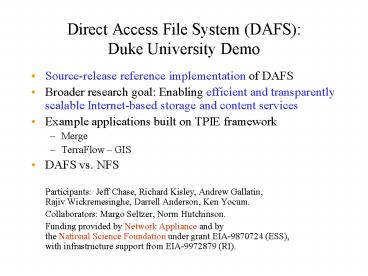Direct Access File System (DAFS): Duke University Demo - PowerPoint PPT Presentation
Title:
Direct Access File System (DAFS): Duke University Demo
Description:
Direct Access File System (DAFS): Duke University Demo Source-release reference implementation of DAFS Broader research goal: Enabling efficient and transparently ... – PowerPoint PPT presentation
Number of Views:86
Avg rating:3.0/5.0
Title: Direct Access File System (DAFS): Duke University Demo
1
Direct Access File System (DAFS) Duke
University Demo
- Source-release reference implementation of DAFS
- Broader research goal Enabling efficient and
transparently scalable Internet-based storage and
content services - Example applications built on TPIE framework
- Merge
- TerraFlow GIS
- DAFS vs. NFS
- Participants Jeff Chase, Richard Kisley,
Andrew Gallatin,Rajiv Wickremesinghe, Darrell
Anderson, Ken Yocum. - Collaborators Margo Seltzer, Norm Hutchinson.
- Funding provided by Network Appliance and bythe
National Science Foundation under grant
EIA-9870724 (ESS),with infrastructure support
from EIA-9972879 (RI).
2
DAFS Demo Testbed
DAFS / NFS Client 256MB SDRAM
DAFS / NFS Server 512MB SDRAM
cLAN
86 MB/s
GigEther
Testbed allows direct comparison of DAFSand NFS
applications
3
TPIE One ApplicationTwo File Systems
DAFS Client
NFS Client
User Applications
User Applications
TPIE Library
TPIE Library
DAFS Client Library
cLAN VIPL Library
copyin/out
DMA
VFS/VM Buffercache
NFS
TCP/IP Stack
cLAN Device Driver
Ethernet Device Driver
DMA
cLAN VIA Adapter
Alteon Gigabit Ethernet Adapter
cLAN VIA
Ethernet
4
(No Transcript)
5
(No Transcript)
6
Benefits of DAFS
- Low I/O overhead
- Copy-avoidance with RDMA
- Improves application performance up to 2x
depending on the I/O demands of the application - Benefits may be much higher since the NFS in our
experiments is highly optimized - User-level networking
- Enabled by the Emulex/Giganet clan VI network
- Reduced protocol overhead on the host
- Reduced context switching on the host
7
TPIE Merge Application
- Key component of external sort algorithm
- Basic primitive of many external memory
applications - Sequential I/O reads and writes
- Merge parameters control compute-I/O ratio
- Merge order increases complexity of merge
computation - Record density (records / MB) increases the
number of merge computations that must be done
between I/Os































